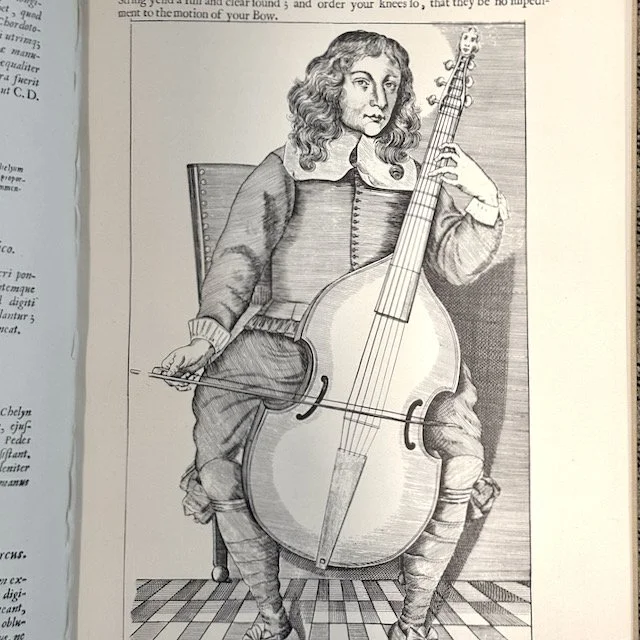AN ARCHTOP GUITAR IS NOT A VIOLIN (IT IS A VIOL)
What instrument has six strings, is tuned in fourths (with a major third mixed in), and has been immensely popular both solo and in small groups for a long time? The Viol. Oh yes, and also the modern guitar.
It may be a surprise to some, but the guitar and all European bowed instruments are descended from the same source: in medieval Iberia there is first mention of the “vihuela de arco” and “vihuela de mano”. We can infer from this that before there was only the vihuela, meaning a plucked instrument with a flat back, of squarish shape, perhaps with incurved sides.
For those who are less obsessed with historical musical instruments, a viol is a bowed stringed instrument which superficially resembles a ‘cello. You might have heard them referred to as a “gamba”, which is short for “viola da gamba”, meaning it was played by being held on or between the legs. Typically they have six gut strings, and frets also made from carefully tied loops of gut. The design changed quite a bit in the early years, but had reached mature form by Elizabethan times. The ones that best fit the contemporary definition were very popular for quite a long time: from the mid-fourteenth to mid-sixteenth centuries.
Solo players like Christopher Simpson or Marin Marais were practically the rock stars of their day, but more commonly one might hear them played in small groups made up of various sizes of viol, from the little treble to the contrabass which has survived nearly intact to the present day as the “double bass”. So popular was this sort of music that is was quite common for a wealthy patron to order a “chest” of viols: two treble, two tenor, and two basses of matching decoration and construction, housed together in a specially constructed cabinet.
The sound of a viol consort is quite different from that of a modern string quartet. It’s not so much four distinct voices working together; it is more like a choir, but made of mellow string sounds. In fact the written music of the era generally didn’t specify instrumentation; most likely it was used relatively interchangeably between viol, voice, or pipe organ. The melodic lines of a viol consort pass seamlessly across the register from one player to another, crossing or merging with other contrasting or harmonizing lines.
As a luthier, I am always interested in how successful instruments from the past were built. While the musical landscape may have changed a lot, there are some elements that remain universal. One: efficiency of sound production. It has to be loud for people to hear it, yet no-one wants to exhaust themselves thrashing a little more volume from a reluctant instrument (surprisingly, an increase in quantity of sound is usually interpreted by our ears as an increase in quality of sound). Two: cost. Then as now, finding a less expensive way to build an instrument while achieving the same result is always desirable. Three: beauty. A good instrument must please the eye and the ear.
From a luthiers point of view, there are several particularities about the way viols are constructed that are worth investigating. Given the popularity (and relative longevity of this popularity) of the viol family, it was obviously hitting the targets of being pleasing to play, pleasing to hear, and practical to own. Those targets are still highly relevant today.
Looking at a viol for the first time perhaps the first surprise is the back. Unlike the violin family, it is flat, with one or several transverse braces. There is a section near the neck that is bent sharply inward to meet the heel; there are two very pragmatic reasons for this, even if it is a tricky extra step in construction. One is that the larger viols lean back against the players ribcage, and so it is an ergonomic consideration. The other (and to my luthiers eye more intuitive) is that a neck blank deep enough for the full depth of the body would harder to find, and more work to carve, and apparently no-one used a stacked heel if they could avoid it.
The sides, or ribs, are substantially thicker than one normally finds on violin-family instruments- perhaps 2.5mm instead of 1.5mm, which doesn’t sound like much until you have it in your hands. While this means viols are more robust in an area that is prone to damage, it is impossible to bend the wood into such small-radius curves as those found on the points of violins. No matter, in my opinion the resulting shapes are pleasing to the eye to such a degree that they almost make a violin outline seem gaudy and rococo.
The tailpiece of a viol has an interesting feature: typically, they have a square hole at the base, which is hooked over a square peg that projects out front from the endblock. In some cases, the peg has several notches. What this means is that the viol player can, if desired, modify the response of their instrument by choosing which notch to use. A higher notch puts less downward force on the bridge, while a lower one puts more, resulting in a somewhat bolder tone.
The neck too holds a surprise, besides the extra width needed to allow finger space for six strings. The fingerboard is a substantial part of the neck, accounting for perhaps half the thickness, and it is often hollowed out quite dramatically. Presumably this is to reduce weight- the neck of the instrument is by necessity made of dense wood like maple, and being played upright the viol is more comfortable to hold when it has a lower centre of gravity. Despite the thicker backs and sides, viol bodies are quite light, so it would be important to keep the necks as light as possible too.
But perhaps the most intriguing feature is that of the soundboard. We know from literary sources that viols from England were especially well-regarded. Seems unusual; viols were also commonly made in many European countries for many years, and aside from some decorative elements they are often very similar. What may have set these English ones apart can only be discerned by a very careful examination of their soundboards. So careful in fact, that the secret was not rediscovered until 1982, by Dietrich Kessler. Most if not all of the viols made in England, before they lost primacy in the seventeenth century, have soundboards that are not simply carved out of a thick bookmatched wedge of spruce; they are primarily bent.
Bent plated are probably a little bit familiar to archtop guitar enthusiasts. The classic Harmony archtop guitars from the 1950s and 60s are famous for having soundboards made from birch plates steamed into shape in an industrial press. There is even a school of violin-making (the Brescian, if I recall correctly) that used a similar technique, where two thin bookmatched halves would be steamed and forced to a curve using an ingeniously simple system of shaped wedges. The old english viols were apparently more complex than that, being made out of five or seven separate pieces! Here’s how:
Five staves are split from a spruce billet, and planed to a thickness of about 6mm. The central stave is the first to prepare; it is not rectangular, but wedge-shaped, narrower at the neck end. It is bent into a gentle arch shape using a heated pipe, or even simply burning coals slotted between two bricks. The sides are planed straight, but with an angled shooting board. Viewed from the end, it is rather like the keystone in a stone archway. Then this is nailed to a workboard.
The two staves to either side are also slightly tapered. Bending them is trickier; they need to follow a rather complex curve to match the central stave on one side, but be relatively flat to the workboard on the other. The inner edge then needs to be planed to an angle which perfectly mates with the central staves.
The final parts are the upper and lower bouts, which don’t require bending. They can be left a little thicker and carved down later.
The pieces are all fitted together on the workboard and glued. The usefulness of the wedge shape can be seen now; by driving nails into the workboard outside the edges, pressure can be applied to the joint by simply tapping the ends of the staves.
After the glue has set, the final carving can be achieved very rapidly, since the soundboard is already near its final shape. Then a wood sound-bar is glued in, conveniently covering the joints between the central stave and the one on the bass side. Finally, strips of linen cloth soaked in hot hide glue are used to cover the remaining joints on the inside.
It seems like a lot of extra trouble to go through, but let’s put ourselves in the place of a medieval craftsman. Early viol-makers especially were probably not specialists; they would have been originally apprenticed and trained as joiners, or coopers, or carpenters. Making musical instruments would have been only one specialized application of a skillset that was both broad and deep: to be able to deal with that magical material called wood, in all possible ways. Obviously some became much more specialized as instrument-maker than others, but still…
In this context, it would not seem like more trouble to bend wood than to carve it. Any journeyman woodworker would have been well-versed in various techniques of bending wood. Not only that, but narrower pieces of wood are (then as now) substantially easier to source (England is not known for having great old-growth stands of spruce). Crucially, in the days before powered bandsaws, it makes it easy to do most of the rough dimensioning by splitting the wood. If the grain is straight, it’s extremely quick to split off five staves of even thickness, and relatively flat- a major time-saver. Also, since the wood is now quite thin and going to be strongly heated anyway, there is no need to wait years for seasoning- it merely needs to be “dry”, which might only require a few months of good weather.
Probably the greatest advantage in using bent instead of carved plates is strength. The fibres of the wood (especially if it is split) will be almost perfectly continuous. This translates into a surprising large increase in stiffness, both along the grain and across it. The soundboard can be made thinner for the same stiffness, translating into better sonic efficiency.
So why not build guitars in this manner too? I propose to do just that. An archtop guitar, with relatively thick bent sides, a flat, braced, back, with a wood tailpiece on a notched post, and heat-bent 5-stave soundboard… why not indeed. The baroque-era viol should have been the original reference model for the archtop guitar, rather than the violin. Building this instrument will be an experiment, but the mechanical theory is sound. And in a way, I’ll be closing a loop of history, re-entwining the evolutionary strands of vihuela “de mano” and “de arco” that have been diverging for nearly a millennium.
Sounds like fun to me!

